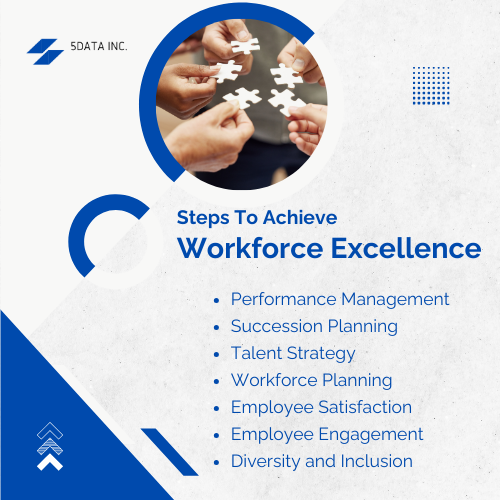It is widely acknowledged that in the evolving arena of business objectives, achieving workforce excellence is not the destination but an ongoing journey. This journey encompasses a complex interplay of elements, with each playing a critical role in molding the path to success and sustainability of an organization. Key components include performance management, succession planning, talent strategy, employee development, workforce planning, and more. In this exploration, we delve into the significance of these aspects, explore innovative strategies propelling workforce excellence, and unravel the inherent benefits that organizations derive from adept workforce management.
Steps To Achieve Workforce Excellence
- Performance Management: It is the cornerstone of workforce excellence. It involves setting clear expectations, providing continuous feedback, and aligning individual goals with broader organizational objectives. By fostering a culture of accountability and recognition, an organization’s workforce can significantly enhance productivity and stimulate sustainable growth.
- Succession Planning: It involves a forward-thinking strategy to recognize and foster upcoming leaders within the organization. This strategic model guarantees a seamless leadership transition, averting disruptions to business operations. By anticipating key roles and developing a pipeline of skilled individuals, succession planning fortifies organizational resilience. This forward-thinking strategy not only mitigates potential gaps in leadership but also cultivates a culture of continuous growth and development. Careful talent cultivation ensures that the leadership landscape remains robust and adaptable, positioning the organization for sustained success in the dynamic business environment.
- Talent Strategy: An effective talent strategy is essential for organizational triumph. It encompasses the attraction, development, and retention of top-tier talent. Utilizing data analytics for talent acquisition, embracing diversity and inclusion, and nurturing an innovative culture is integral to a progressive talent strategy. Employee retention is as crucial as attraction contented enhance customer experiences, profoundly influencing satisfaction and loyalty. Acknowledging and harnessing current talent entails establishing transparent career paths within the organization. It not only inspires employees but also guarantees a consistent influx of skilled individuals for future leadership positions.
- Workforce Planning: Strategic workforce planning transcends mere headcount, focusing on future readiness. Organizations must foresee skills gaps, embrace tech advancements, and cultivate a flexible workforce for industry shifts. Utilizing agile methodologies and scenario-based planning is pivotal. Effective workforce planning, coupled with talent acquisition, is indispensable. Anticipating future needs is key to attracting and retaining top talent. An inclusive workforce sparks innovation, and a supportive, inclusive environment fosters collaboration. Aligning workforce strategies with the overall business approach ensures unified growth. Identifying and offering growth opportunities is vital for business success in this forward-thinking paradigm.
- Employee Satisfaction And Engagement: Employee engagement and job satisfaction propel companies’ success. Prioritizing work-life balance, career development, and well-being cultivates a positive workplace culture. Innovative strategies include real-time feedback, personalized development plans, and wellness programs. Leveraging technology in workforce management streamlines processes and amplifies decision-making. Learning management systems, data analysis, and AI-driven tools foster effective talent development, succession plans, and performance evaluations. Automation of routine tasks liberates time for strategic initiatives, ensuring a forward-thinking approach to workforce optimization. Data Collection and Data Management Service Providers offer comprehensive solutions for gathering and organizing information, ensuring efficient and accurate handling of valuable employee data.
- Diversity and Inclusion: They are not just trendy phrases but are critical for fostering innovation and resilience. Organizations must transcend superficial gestures and wholeheartedly embrace inclusivity across all levels. Diverse teams bring a wealth of perspectives, nurturing creativity and facilitating effective problem-solving. Maintaining a robust lifestyle balance is pivotal for employee well-being. Organizations that prioritize this equilibrium create a positive atmosphere, resulting in heightened job fulfillment and improved retention rates. An inclusive workforce catalyzes innovation and creativity. A supportive work environment that values diversity fosters collaboration and inclusivity. Analyzing analytics and conducting employee surveys provides invaluable insights for enhancing the overall employee experience. Application Development Services cater to the creation and enhancement of software applications, tailoring solutions to meet the specific needs and goals of business strategy.

Benefits Of Workforce Management
Workforce management offers several benefits to organizations, including:- Enhanced Employee Productivity: A well-managed workforce is a productive workforce. Clear expectations, continuous feedback, and technical skills development contribute to increased productivity.
- Talent Retention and Cost Savings: Retaining existing talent is not only cost-effective but also ensures institutional knowledge and a stable workforce. Reduced turnover leads to significant cost savings associated with recruitment and training initiatives by the human resources team.
- Strategic Adaptability: Agile workforce management allows organizations to adapt swiftly to changing market conditions. This adaptability is crucial for survival in a rapidly evolving business landscape.
- Positive Company Culture: A positive employee experience in the company culture, cultivated through effective workforce management, draws in top-tier talent and establishes an atmosphere where employees thrive.
- Informed Decision-Making: Data-driven workforce management provides insights that enable informed decision-making. It is critical for resource allocation, talent sourcing, and strategic planning.
- Leadership Development: Succession plans and leadership development programs ensure a continuous pipeline of capable leaders, fostering organizational resilience.
- Adaptability to Technological Changes: Using coaching programs and embracing technology in workforce management ensures organizations stay ahead in the digital age and reduce the skills gap. Automation and data analysis contribute to professional development processes.
Innovative Strategies For Workforce Excellence
The subsequent innovative approaches center on utilizing technology, giving precedence to employee well-being and establishing a supportive and collaborative workplace to elevate workforce excellence.- Predictive Analytics for Talent Management: Use predictive analytics to identify emerging skills needed for tailoring future talent management strategies accordingly.
- Employee-Centric Technology Platforms: Implement user-friendly platforms that empower employees to manage their development, set goals, and access learning resources.
- Virtual Reality (VR) for Training: Harness VR technology for immersive and effective training experiences, especially for roles requiring hands-on skills.
- Gamification for Engagement: Introduce gamification elements in training programs and daily work tasks to enhance engagement and promote a culture of healthy competition.
- Blockchain for Credential Verification: Utilize blockchain technology for secure and transparent verification of employee credentials, fostering trust in talent sourcing.
- Remote Work Strategies: Develop sustainable remote work strategies that prioritize employee achievements and well-being, maintain productivity, and ensure effective communication.
- Holistic Well-Being Programs: Broaden well-being initiatives to encompass beyond physical health encompass mental and emotional well-being as well. It includes counseling services, mindfulness programs, and stress management initiatives.
- Cross-Functional Collaboration Platforms: Implement collaboration platforms that facilitate cross-functional teamwork, breaking down silos and encouraging knowledge sharing.
Bottomline
Workforce excellence is a dynamic pursuit that demands continuous innovation and strategic adaptability. Organizations must embrace a holistic approach, integrating performance management, succession planning, talent strategy, and cutting-edge technologies to stay ahead. The benefits of effective workforce management extend beyond the workplace, influencing customer satisfaction, market competitive advantage, and overall organizational resilience. As we navigate the evolving landscape of work, workforce excellence becomes not just a goal but a strategic imperative for shaping a future-ready and successful organization.
Rasmita Patro
Author
